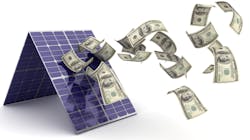I have been having trouble deciding what to write about in relation to all the legislation taking effect, like the Inflation Reductions Act, the Infrastructure Investment and Jobs Act, etc. that have been passed recently. The enormity of subject matter is hard to wrap your head around, but all of these legislation acts and laws are going to have an immense impact on the power delivery system in many ways. The clean energy aspects alone are going to change business and operational models a great deal.
As I thought about the magnitude of what was going on, a TV commercial caught my attention. It focused me on a portion of the industry that was better defined and more specific in nature, the consumer energy segment. The commercial had opened with a beat-up old HVAC (heating, ventilation, and air conditioning) outdoor unit on screen and smoke coming from one corner of the unit.
It had seen its better days for sure. The announcer went into his spiel about needing to replace old-school HVAC technologies with state-of-the-art, energy efficient heat pumps. It would be paid for with the recently enacted tax credits. If you remember last month’s "Charging Ahead’s"' editorial I had trouble with my own HVAC that had been resolved, but it was still on my mind. So I listened. After all, my unit is old and could possibly need replacement. The commercial had succeeded in getting my attention. I watched, but my engineering mindset was having trouble accepting the facts that tax credits would pay for it, which sounded too good to be true.
It's Complicated
Digging deeper revealed the tax credits were applied to the cost. They didn’t pay the total cost. I found another tax credit program in my web search. This one was said to pay for the installation of rooftop solar systems behind-the-meter (BTM). And like the heat pump program, this tax credit plan offset the solar purchase and installation cost by 30%. Associated with the solar tax credit program was another offshoot offering a 30% tax credit toward the purchase of energy storage systems. A 30% discount for solar-plus-storage is going to get attention!
These types of tax credits may be just the stimulus needed to push any reluctant fence-sitting consumers into purchasers. They have been installing solar-plus-storage in record setting numbers for many years without these incentives, but this could be a whole new ballgame for the BTM segment. With solar and storage costs dropping, and now offering tax credits, it’s a good time for those adding renewables at the grid’s edge.
Simple Tools
Interestingly, there are some sophisticated estimating tools available to aid consumers when it comes to calculating sizing, costs, and paybacks. A simple internet search found many of them, but one of the user friendliest comes from Google. They developed a rather amazing web site called Google Project Sunroof.
It’s a solar calculator based on satellite imagery from Google Earth. It uses machine learning to identify rooftops, trees, and determine the available light from the sky. Google’s engineers did all the heavy lifting as far as the math, 3D geometry, weather pattern data, and conversion of solar to kilowatt-hours. It needs a little fine tuning with actual suppliers/installers, but gives a great ballpark estimate.
I typed in my address and the software did the rest. I had an aerial view of my house with the square footage I could cover with panels. The program told me that my roof averaged about 2,174 hours of usable sunlight per year. Then it calculated how many kilowatts (kW) I needed based on my average electric bill to provide 99% of my electricity usage.
It went on to tell me that with federal, state, and local incentives the purchase/installation price of solar panels would cost me about US$10,000 for 4.25 kW. I would see payback in roughly 10 years – less if electric rates went up and prices continued downward. Personally I would add energy storage, and there’s a tax credit for that too. I would make it a nanogrid too, but that’s another story.
According to the Solar Energy Industries Association, resident solar installations set a record in 2021 by exceeding 4.2 gigawatts. It was also the first time that more than 500,000 residential solar projects were installed in one year. It’s going to be interesting to see how these tax credits will change those statistics next year, and how the industry reacts.
About the Author
Gene Wolf
Technical Editor
Gene Wolf has been designing and building substations and other high technology facilities for over 32 years. He received his BSEE from Wichita State University. He received his MSEE from New Mexico State University. He is a registered professional engineer in the states of California and New Mexico. He started his career as a substation engineer for Kansas Gas and Electric, retired as the Principal Engineer of Stations for Public Service Company of New Mexico recently, and founded Lone Wolf Engineering, LLC an engineering consulting company.
Gene is widely recognized as a technical leader in the electric power industry. Gene is a fellow of the IEEE. He is the former Chairman of the IEEE PES T&D Committee. He has held the position of the Chairman of the HVDC & FACTS Subcommittee and membership in many T&D working groups. Gene is also active in renewable energy. He sponsored the formation of the “Integration of Renewable Energy into the Transmission & Distribution Grids” subcommittee and the “Intelligent Grid Transmission and Distribution” subcommittee within the Transmission and Distribution committee.
